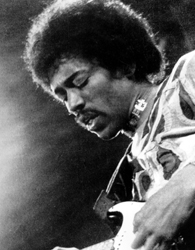Jimi Hendrix revolutionized rock during the late 1960s with his songwriting, guitar playing and outrageous stage moves. Although he died young, his music and style of playing have continued to influence contemporary musicians over the years.
Jimi Hendrix’s Early Days
Johnny Alex Hendrix was born in Seattle, Washington on November 27, 1942. Four years later, his father changed his name to James Marshall Hendrix. When he was 16 years old, Hendrix’s father gave him his first electric guitar, and Hendrix joined a local rock band, the Rocking Kings. In 1959, Hendrix joined the army and served briefly as a paratrooper before being discharged in 1962 due to injury.
Hendrix then moved to New York City, and throughout the mid-1960s, he played as a backup guitarist for such musicians as Ike and Tina Turner, Little Richard, the Isley Brothers and B.B. King. Hendrix also recorded as a session man, most notably on the Isley Brothers’ single, “Testify.”
During this time, Hendrix formed his own group, Jimmy James and the Blue Flames, and began playing the club circuit in New York’s Greenwich Village. In 1966, Hendrix got his big break when Chas Chandler, the bass player of the Animals, spotted him performing in a club.
Sources in this Story
- Rock and Roll Hall of Fame: The Jimi Hendrix Experience
- The Official Jimi Hendrix Website: Jimi Hendrix Biography
- YouTube: Jimi Hendrix—Wild Thing (live) (Guitar Sacrifice)
- Rolling Stone magazine: Jimi Hendrix Biography
- Biography.com: Jimi Hendrix Biography (1942–1970)
- IMDb: Jimi Hendrix (1973)
- Museum of Pop Culture
Hendrix’s Notable Accomplishments
In 1966, Chandler brought Hendrix to London to record. Hendrix was introduced to bassist Noel Redding and drummer Mitch Mitchell, and together the three musicians formed the Jimi Hendrix Experience. In 1967, the Jimi Hendrix Experience released three Top Ten hits in the United Kingdom: “Purple Haze,” “Hey Joe” and “Wind Cries Mary.” All three songs appeared on the group’s first album, 1967’s “Are You Experienced?” British audiences loved Hendrix’s energetic live performances.
Hendrix returned to the United States in the summer of 1967 to perform at the Monterey International Pop Festival. Hendrix’s set at the festival included his legendary performance of “Wild Thing” that ended with Hendrix lighting his guitar on fire.
By the end of 1967, Hendrix was an international superstar, captivating people with his virtuoso guitar playing, his catchy songwriting and his electrifying showmanship. In 1968, the Jimi Hendrix Experience released their second album, “Axis: Bold as Love.” The group’s third and final album, “Electric Ladyland,” followed later that year and featured the hit single “All Along the Watchtower,” written by Bob Dylan.
The Jimi Hendrix Experience continued to tour extensively, although Hendrix was under increasing strain because of disagreements between the bands’ two co-managers and demands from the Black Power community for Hendrix to lead an all-black band. In 1969, the Jimi Hendrix Experience broke up, and Hendrix did form an all-black band, the Band of Gypsys. In 1969, he performed at Woodstock with a group of musicians he called the Electric Sky Ensemble, where Hendrix demonstrated his musical skills with a guitar rendition of “Star-Spangled Banner.”
The Man and his Work
- “Jimi Hendrix” (DVD)
- “’Scuse Me While I Kiss the Sky: Jimi Hendrix: Voodoo Child” by David Henderson
- “The Jimi Hendrix Experience” (CD box set)
- “Are You Experienced” (CD)
- “Jimi Hendrix: Live at Monterey” (DVD)
The Rest of the Story
Jimi Hendrix was 27 when he died on September 18, 1970, after an apparently accidental overdose of barbiturates. At the time of his death, he had been recording a new album, “First Rays of the New Rising Sun.” Dozens of live and unreleased studio recordings have since been posthumously produced under Hendrix’s name.
The authorized documentary “Jimi Hendrix” was released in 1973. In 1992, The Jimi Hendrix Experience was inducted into the Rock and Roll Hall of Fame. Microsoft cofounder and Hendrix fan Paul Allen helped Hendrix’s father win a legal battle for control over Hendrix’s estate and the rights to his recordings. In 2000, Paul Allen opened the Experience Music Project in Seattle, which became the Museum of Pop Culture. The museum, designed by Frank Gehry, pays tribute to Hendrix and hundreds of other musicians and artists.
This article was originally written by Caleb March; it was updated November 27, 2017.











